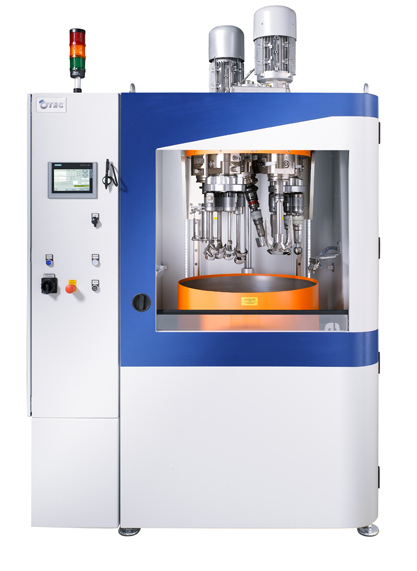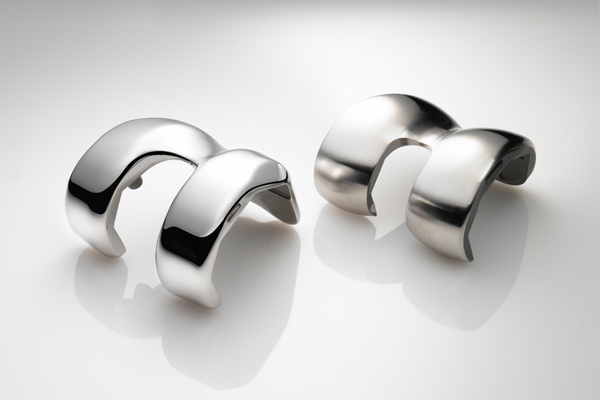Polishing of knee implants
Mass finishing of joint implants
The contact surfaces of hip and knee implants must be homogeneous, precise and very smooth. In order to achieve this, OTEC has developed special mass finishing processes for drag finishing.
In this process, the workpieces are clamped in specially designed holders and drawn through a series of grinding and polishing media in a number of processing stages. Clamping the workpieces eliminates any danger of damage caused by the workpieces colliding with each other. Especially when treating the complex surface geometry of a knee joint, it is important for the material to be removed evenly during grinding and polishing, in order to ensure a perfect fit. For this purpose, OTEC has carried out numerous trials and developed workpiece holders which guarantee precisely this. As a rule, items such as knee joints are processed in two stages as follows:
1. Wet grinding
During wet grinding the knee joints are dragged through a special plastic abrasive media. A water/compound mixture is added to the media in a continuous flow process; this mixture carries away the material removed and is discharged into an external process water treatment system (such as a microfiltration unit). This flow through process ensures that the workpiece remains clean at all times. The
water/compound concentration can be preset by means of the Siemens S 7 control unit, considerably improving the consistency and reliability of the process. By varying the depth to which the workpiece is immersed in the media and the speed of rotation, and thereby controlling the contact pressure of the abrasive on the workpiece, this process can achieve Ra values of up to 0.08 μm. The processing time for this is about 2 – 3 hours. After wet grinding, the workpieces are in such a perfect condition that they can be polished immediately.

2. Dry polishing
During dry polishing, the knee joints are dragged through specially treated (impregnated) natural abrasive media such as walnut shell granulate. During impregnation, the granules receive a coating which basically consists of a special oil and aluminium oxide. The motion of the workpiece through the granulate and the
resulting friction smoothes and polishes the workpiece. This process enables surfaces with Ra values of up to 0.01 μm to be achieved. This corresponds to the surface quality attained by manual polishing. The oil/aluminium oxide powder mixture has to be replenished at regular intervals in the form of a polishing cream in order to maintain a consistent polishing performance. The processing time is normally 1 – 2 hours.

The DF series of OTEC drag finishing machines can also be equipped to carry out both process stages automatically. This eliminates the time-consuming procedure of removing and reclamping the workpieces. A further key advantage of the OTEC technology is a high degree of reliability. All relevant parameters can be set at the machine, documented and stored as programs. In order to obtain perfect results for any giving application, it is essential to choose right combination of all relevant process parameters. In order to determine the most suitable process, potential customers are invited to take advantage of the sample finishing service offered by OTEC’s finishing center. This service is available worldwide!




